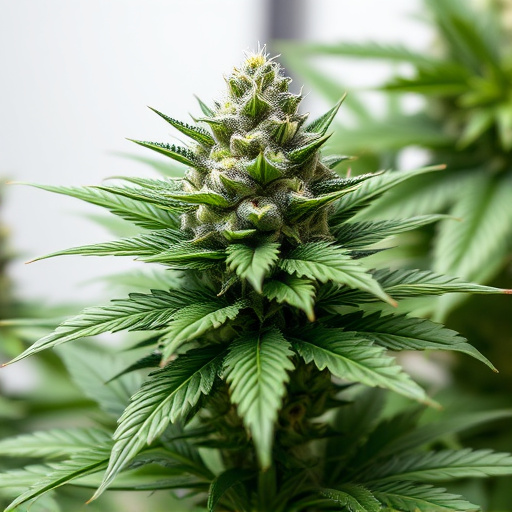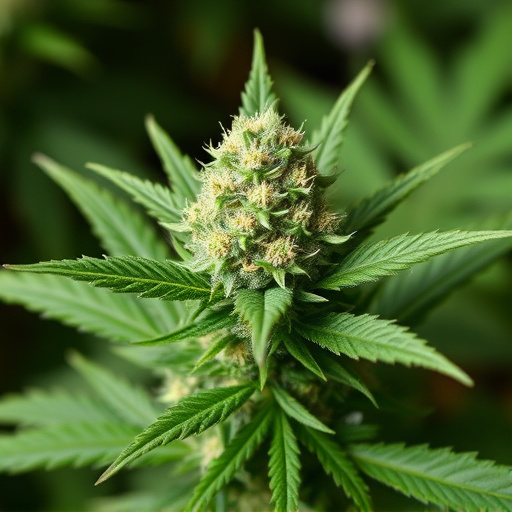Strong cannabis strains, characterized by high THC levels, interact with the body's endocannabinoid system (ECS) to significantly impact appetite. This interaction can stimulate ghrelin, increasing hunger, or suppress leptin, decreasing appetite, leading to varied eating experiences. Understanding this dynamic is crucial for both medical and recreational users, as it highlights potential benefits for conditions like anorexia but also raises concerns about diet and lifestyle adjustments. Further research is needed to explore long-term effects and develop strategies to mitigate any adverse impacts on eating behaviors associated with regular strong cannabis strain consumption.
“Unraveling the complex relationship between THC and hunger hormones reveals a fascinating interplay that can significantly impact our appetite. This article explores how tetrahydrocannabinol (THC), the primary psychoactive compound in cannabis, influences the body’s natural hunger signals. We delve into the science behind THC’s effects on key hunger hormones, offering insights into why strong cannabis strains may stimulate or suppress appetite. By understanding these mechanisms, we can better appreciate the multifaceted impact of cannabis consumption.”
- Understanding THC and Its Impact on the Body
- The Role of Hunger Hormones and How THC Interacts With Them
- Effects of Strong Cannabis Strains on Appetite and Eating Behaviors
Understanding THC and Its Impact on the Body

THC, or tetrahydrocannabinol, is the primary psychoactive compound found in cannabis plants, particularly in strong cannabis strains. It interacts with the endocannabinoid system (ECS), a complex signaling network within the body that regulates various physiological processes, including appetite and metabolism. When THC binds to specific receptors in the ECS, it can alter hunger hormones, leading to feelings of either increased or decreased appetite.
Research suggests that THC’s impact on hunger is multifaceted. It can stimulate the release of ghrelin, often referred to as the “hunger hormone,” which signals the brain to induce eating. Conversely, THC may also suppress the activity of another hormone, leptin, responsible for signaling satiety and reducing appetite. This dual effect contributes to the varied experiences individuals have when consuming cannabis, with some reporting heightened hunger and others experiencing a loss of appetite, especially with higher THC concentrations in strong cannabis strains.
The Role of Hunger Hormones and How THC Interacts With Them

The hunger-regulating system in our bodies involves a complex interplay of hormones, with key players including leptin and ghrelin. Leptin signals satiety to the brain, while ghrelin stimulates appetite. These hormones work together to maintain energy balance. Interestingly, tetrahydrocannabinol (THC), the primary psychoactive compound in strong cannabis strains, has been shown to influence these hunger hormones. When consumed, THC can interact with the endocannabinoid system, a network of receptors and neurotransmitters that modulate various physiological processes, including appetite. It binds to CB1 receptors in the brain, which are involved in appetite regulation, leading to potential changes in ghrelin and leptin levels. This interaction may explain why some individuals experience increased hunger or cravings after consuming cannabis, while others report reduced appetite. Understanding these effects is crucial for both medical and recreational users, as it highlights the potential benefits and challenges of incorporating cannabis, particularly strong strains, into one’s diet and lifestyle.
Effects of Strong Cannabis Strains on Appetite and Eating Behaviors

Strong cannabis strains, characterized by their high tetrahydrocannabinol (THC) content, have been shown to significantly impact appetite and eating behaviors. THC interacts with the endocannabinoid system in the brain, which plays a crucial role in regulating hunger and satiety. Studies suggest that potent cannabis varieties can stimulate appetite, leading to increased food intake and potential weight gain over time. This effect is particularly noticeable among individuals who consume cannabis for recreational purposes or those using it therapeutically to manage conditions like anorexia or cachexia.
The heightened appetite induced by strong cannabis strains may result in altered eating patterns. Users often report a desire for high-calorie, high-fat foods, which can contribute to overeating. While this phenomenon has been well-documented, the underlying mechanisms are complex and not fully understood. Further research is needed to determine the long-term effects of regular consumption and to explore potential strategies for mitigating any adverse impacts on eating behaviors.
THC, the active compound in cannabis, significantly influences hunger hormones, as evidenced by its impact on appetite and eating behaviors. The interaction between THC and these hormones, particularly ghrelin and leptin, offers insights into why strong cannabis strains can stimulate or suppress appetite. Understanding these effects is crucial for navigating the consumption of strong cannabis strains, highlighting potential benefits for medical users while also cautioning against overeating or eating disorders. Further research is needed to fully comprehend the complex relationship between THC, hunger hormones, and overall health.














